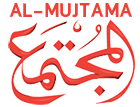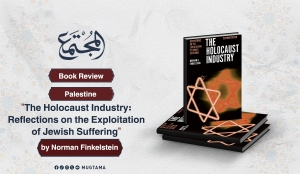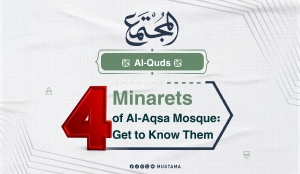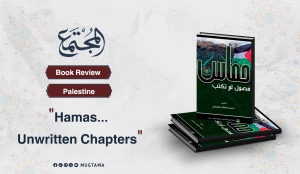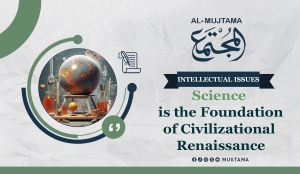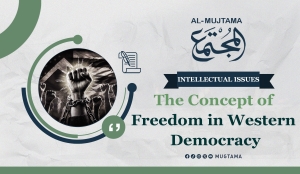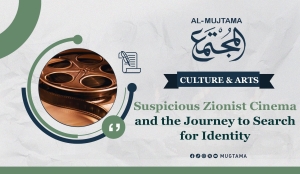Nada Gamal
A reading of the book "The Holocaust Industry: Reflections on the Exploitation of Jewish Suffering
February 17, 2025The book "The Holocaust Industry: Reflections on the Exploitation of Jewish Suffering" is a critical work by American Jewish academic and researcher Norman Finkelstein, published in 2000. It addresses the topic of the "Holocaust" from two main perspectives: the first concerns the interpretation of the narrative surrounding the "Holocaust," and the second focuses on how that narrative is exploited for political and commercial purposes.
The book stirred wide controversy, as it faced criticism from some Jewish and Zionist circles. It was translated into Arabic twice; the first time by Samah Idris in 2000, and the second time by Saud Attia in 2001.
Finkelstein criticizes the excessive and misleading use of the history of the "Holocaust" by certain groups and organizations, particularly those that benefit from perpetuating the image of the Jewish victim.
He believes that some Jewish organizations, such as the "American Jewish Union," have exploited the "Holocaust" as a political pressure tool to achieve their interests, such as strengthening military and financial support for the occupying state.
It also directs sharp criticism at some academics who work to establish the image of the "Holocaust" as a unique event that cannot be questioned, despite the fact that the book calls for recognizing other historical atrocities such as the Armenian genocide.
Finkelstein compares the "Holocaust" to the suffering of other minorities that have faced persecution and extermination in various parts of the world, warning against the selective use of the "Holocaust" to pressure people or distort historical facts.
The media figure Ahmad Mansour says in an interview on the program "Without Boundaries" with the author of the book in 2004: "Although the book does not exceed 160 pages, the number of articles written about it is not in the dozens, but in the hundreds. These articles have been published in most Western newspapers, especially the reputable and famous ones."
Mansour added that the book presents a bold study that reveals the "Holocaust" industry, unveiling the groups behind it and their objectives, as well as the means and methods employed by the Jewish lobby to blackmail countries around the world.
The book, according to Mansour, also discusses how these individuals obtained tens of billions of dollars in compensation for the victims of the "Holocaust," which were subsequently distributed to "Israel" and Jewish groups, in addition to layers of lawyers and other beneficiaries.
The main axes of the book.
- The Manufacture of the 'Holocaust
The book indicates that the "Holocaust" has become part of a cultural and historical industry that benefits a certain group, and how the Jews have been able to exploit this suffering to achieve political, economic, commercial, and social gains. It sharply criticizes the Zionist and Jewish institutions, some of which profit from this suffering.
- political exploitation
The book explains how the "Holocaust" is used by some political powers to achieve special interests, and how it is exploited as a tool for political and economic manipulation, focusing on how Zionist institutions and some governments exploit this historical event to achieve material and moral gains.
- Skepticism about the official narrative
The author calls for a critique and review of some academic and media positions related to the "Holocaust," and the exaggeration in presenting its events in order to create a public opinion and a broad narrative around it, which affects the objective understanding of historical events in favor of the Jews.
- The role of "Israel" in exploiting the "Holocaust":
The text discusses how the occupying state has used the "Holocaust" as a means to enhance its political legitimacy and international support, and how it is exploited to justify "Israel's" policies against the Palestinians, gain international sympathy for them, and strengthen its position in the conflict.
4 Minarets of Al-Aqsa Mosque: Get to Know Them
February 12, 2025The Al-Aqsa Mosque has four minarets, all of which were built during the Mamluk era, between the years 677-769 AH (1278-1367 AD). Three of these minarets are located along the western side of Al-Aqsa Mosque, starting from Bab al-Ghawwamah (the Gate of the Ghawwamah), then Bab al-Silsilah (the Gate of the Chain), and finally Bab al-Magharbah (the Gate of the Moroccans). The fourth minaret is situated on the northern side, between Bab al-Asbat (the Gate of the Tribes) and Bab al-Hutta (the Gate of Hutta).
The absence of minarets on the southern and eastern sides is due to the fact that Al-Aqsa was built on a hill that rises in the middle and north and declines in the east and south. Minarets require a solid and elevated location. Additionally, human and residential activity after the Umayyad period was concentrated in the western and northern areas, making the need for minarets in these regions greater than in others.
- 1. Minaret of Bab al-Magharbah (The Honorary Minaret):
This minaret is located at the southwestern corner of Al-Aqsa Mosque, close to Bab al-Magharbah, precisely above the northwestern corner of the Women's Mosque. It is named the Honorary Minaret in reference to Sheikh Judge Sharaf al-Din ibn Fakhr al-Din al-Khalili, the custodian of Islamic endowments in the city of Jerusalem, who oversaw its construction along with the nearby Fakhriah School in the year 677 AH (1278 AD).
This minaret was built without a foundation and is considered the smallest minaret of Al-Aqsa Mosque, standing at only 23.5 meters tall. The upper part of it was damaged in an earthquake in 1341 AH (1922 AD), after which the Higher Islamic Council demolished and rebuilt it in the same year in a beautiful style, placing a dome on the upper square that had not existed before. Recently, the Al-Aqsa Mosque Reconstruction Committee restored it and covered its dome with lead.
Today, one can ascend to the minaret from the courtyards of Al-Aqsa Mosque via 50 steps leading up to the Islamic Museum (formerly the Mosque of the Moroccans). For many years, the minaret has been fighting attempts by the occupiers to silence the call to prayer, claiming that it disturbs them, which forced the Islamic Waqf Administration in Jerusalem to adjust the loudspeakers so that they point inward towards Al-Aqsa and reduced their volume, depriving the residents of the village of Silwan, located south of the blessed Al-Aqsa, from hearing its call.
- 2. Minaret of Bab al-Silsilah:
It stands above the western arcade of the Al-Aqsa Mosque, slightly to the north of Bab al-Silsilah, and is also known as the Minaret of the Court, as it is located near the Sharia Court building, which is also known as the Tinkaz School.
Both the minaret and the school are buildings of Prince Sayf al-Din Tinkaz al-Nasiri, built in the year 730 AH (1329 AD) during the reign of Sultan al-Malik al-Nasir Muhammad ibn Qalawun. The Higher Islamic Council rebuilt it after an earthquake damaged it in 1341 AH (1922 AD), and it was also restored a few years ago by the Al-Aqsa Mosque Reconstruction Committee.
One can ascend to it through the entrance of the Ashrafiya School via approximately 80 steps. Its base is square, and it stands at a height of 35 meters.
The Minaret of Bab al-Silsilah is considered the only minaret among the four minarets of Al-Aqsa Mosque from which the muezzins have been calling the adhan daily until the use of loudspeakers began in the muezzins' room facing the gate above the courtyard of the Dome of the Rock.
The minaret is located in a very sensitive position, overlooking the occupied Buraq Wall, which has been referred to as the Western Wall by the occupation since 1967.
3- Minaret of Bab al-Ghawanima:
It is located on the northern arcade of the blessed Al-Aqsa Mosque at its far west near Bab al-Ghawanima, which is named after it. Its current construction dates back to the era of Sultan al-Malik al-Mansur Hossam al-Din Lajin in the year 697 AH / 1297 AD, but some archaeologists state that it was originally built during the Umayyad period. It was renewed during the reign of the Mamluk Sultan al-Nasir Muhammad bin Qalawun in 730 AH / 1329 AD, and it was named "Qalawun Minaret." It was also called the Minaret of the Saraya due to its proximity to the Saraya building located outside Al-Aqsa Mosque, which served as a seat of authority during the Mamluk period. The Islamic Supreme Council renewed it in 1346 AH / 1927 AD during the British occupation.
It is the tallest and most ornate minaret of the blessed Al-Aqsa Mosque, with a height of 38.5 meters, and it rests on a square base, while its upper part is octagonal, accessed by 120 steps. Due to its height, which overlooks various aspects of Al-Aqsa, the Zionists sought to control it through the adjacent Omariyah School, which the occupying municipality had taken over since the beginning of the occupation. Additionally, the western tunnel opened in 1996 passes near the foundations of this minaret, resulting in its cracking, necessitating its last restoration in 2001.
4- Minaret of Bab al-Asbat:
This minaret is located on the northern arcade of the blessed Al-Aqsa Mosque between the gates of al-Asbat and Hatta. It is also known as the "Sulaymaniyah Minaret" because it is located near the Sulaymaniyah School outside the blessed Al-Aqsa Mosque, which became the Church of St. Anne during the Ottoman period.
This minaret was built during the reign of Mamluk Sultan al-Ashraf Shaban under the supervision of Prince Sif al-Din Qutlubgh in the year 769 AH / 1367 AD on a square base like the other minarets of Al-Aqsa. During the Ottoman period, it was rebuilt in a cylindrical shape similar to the Ottoman minarets, becoming the only cylindrical minaret in Al-Aqsa.
Its height is 28.5 meters, and it was cracked due to an earthquake in 1346 AH / 1927 AD, forcing the Islamic Supreme Council to demolish its upper section and rebuild it anew. When the Zionist occupation of Jerusalem occurred in 1967, the minaret was damaged from being hit by shells, and it was completely restored afterward by the Committee for the Reconstruction of the Blessed Al-Aqsa Mosque, and its dome was covered with lead.
Book Review: "Hamas... Unwritten Chapters
February 10, 2025
The book "Hamas... Unwritten Chapters" is published by the Zaytuna Center for Studies and Consultations in Beirut and authored by the Palestinian writer Dr. Azam Tamimi. The book, spanning 343 pages in medium size, offers the first two chapters for free download, allowing readers to access the beginning of this in-depth study on the "Hamas" movement.
New Chapters in the Movement's History
The book is a qualitative addition to understanding the "Hamas" movement's vision for itself and the world around it. It discusses the Palestinian-Israeli conflict from the movement's perspective, outlining its positions on various means of conflict resolution, revealing the principles that "Hamas" adheres to, and highlighting what it can accept for settlement and what political options it rejects.
The First Edition in Arabic
The first edition of this book was published in English in 2007 by Hurst Publishing in London. The Arabic edition presented by the Zaytuna Center is the first translated into Arabic, making it an essential reference for researchers interested in the subject.
Chapters of the Book
Chapter One: Beginnings:
The book begins by reviewing the incident that ignited the spark of the Palestinian uprising on December 8, 1987, as well as the conditions that contributed to the birth of the "Hamas" movement afterward. It also highlights the developments that occurred in the two decades leading up to the establishment of the movement.
Chapter Two: From Call to Jihad:
This chapter addresses the story of the "Muslim Brotherhood in Palestine" since 1977 when they began planning to launch their own resistance project, which took practical shape with the onset of the Palestinian uprising in 1987. It clarifies the role of Islamic institutions such as the Islamic Association and the Islamic University in supporting Palestinian society.
Chapter Three: Total War:
This chapter covers the development of the "Hamas" movement and the significant events that affected it after its establishment, starting from the repercussions of the First Intifada to the Oslo Accords signed between the Palestine Liberation Organization and "Israel" in 1993.
Chapter Four: To Jordan:
This chapter narrates the story of the transfer of the leadership of the "Hamas" movement to Jordan following Saddam Hussein's invasion of Kuwait and the pressures faced by the Jordanian authorities as a result of the Wadi Araba peace agreement. It also reviews the incident of Dr. Moussa Abu Marzook's detention in New York and the outcomes of this case.
Chapter Five: The Attempt on Mashal’s Life:
This chapter recounts the failed "Israeli" assassination attempt on Khaled Mashal, and the unexpected consequences that followed, which helped to strengthen "Hamas's" position.
Chapter Six: Exiting Jordan:
This chapter discusses the events that led to the complete expulsion of the "Hamas" movement from Jordan.
Chapter Seven: The Liberation Ideology of Hamas:
This chapter presents "Hamas's" stance on Jews and the state of "Israel," and it discusses the military means the movement relies on to resist occupation, including martyrdom operations. It also highlights the evolution of the movement's political discourse since the issuance of its charter in 1988.
Chapter Eight: Jihad and Martyrdom:
This chapter addresses contemporary discussions surrounding the issue of martyrdom within contemporary Islamic political thought.
Chapter Nine: "Hamas," "PLO," and "Palestinian Authority":
This chapter discusses "Hamas's" position on "Fatah," its primary competitor on the Palestinian scene, and the complex relationships between the two movements.
Chapter Ten: Towards a Third Intifada:
The book concludes by addressing the repercussions of Yasser Arafat's death in November 2004, the developments that led to "Hamas's" victory in the 2006 legislative elections, and the attempts made by the movement's opponents to politically weaken it.
---------------
Science is the Foundation of Civilizational Renaissance
February 08, 2025- Knowledge is the path to elevation and glory, crucial for achieving success in various fields of life.
- The civilizations of David and Solomon, peace be upon them, flourished due to their knowledge in various sciences.
- Islam emphasizes the importance of knowledge, as seen in the first revelations to Prophet Muhammad, peace be upon him. Islam encourages the pursuit of both religious and worldly sciences to build a well-rounded and advanced society.
- The spread of ignorance and decline of knowledge are threats to the survival and prosperity of civilizations.
- The Prophet Muhammad, peace be upon him, emphasized learning languages and knowledge to protect and advance the Ummah.
Historical books and biographies narrate from Ibn Abbas, who said: When the Messenger of Allah, peace be upon him, passed away, I said to a man from the Ansar, "Let us ask the companions of the Messenger of Allah, peace be upon him, for they are many today." He replied, "How surprising of you, O Ibn Abbas! Do you think people need you while among them are the companions of the Prophet whom you see?" Ibn Abbas said: So he left it, but I continued to pursue the questions. If a hadith would reach me from a man, I would go to him while he was taking a nap, and I would lay my cloak at his door, letting the wind blow dust over me. When he came out and saw me, he would say, "O cousin of the Messenger of Allah, shouldn't you have sent for me, and I would come to you?" I would reply, "I am more deserving to come to you and ask you." The man remained until he saw people gathering around me, and he said, "This young man is wiser than I."
What this honorable companion meant by "This young man is wiser than I" is that knowledge is the path to elevation and glory.
Anyone looking into the history and conditions of nations understands that achieving glory in any field of life is based on knowledge. Whether this knowledge is related to religious sciences or various life sciences such as experimental sciences like medicine, engineering, economics, and trade, or humanities and social sciences, they all integrate to contribute to the rise and advancement of society. Since knowledge is the foundation of civilizational progress, the Islamic nation today is in dire need of embracing the causes of progress to restore its glory and honor.
Science as the Foundation of Civilization in Previous Nations
The Quran is the most truthful source informing us about the foundation of civilizational progress in nations before Islam, such as the civilizations of David and Solomon, peace be upon them. Allah says: "And We gave knowledge to David and Solomon, and they both said, 'Praise be to Allah, who has favored us over many of His believing servants.'" (Surat An-Naml, 15). "And Solomon inherited David. He said, 'O people, we have been taught the language of birds, and we have been given from everything. Indeed, this is a clear favor.'" (Surat An-Naml, 16).
These verses speak of Allah's favor upon David and Solomon with knowledge, which encompassed all kinds of sciences, as indicated by Allah's words: "and we have been given from everything."
Al-Bahi Al-Khuli said: "The fruit of this knowledge in this civilization is the control over the laws of nature and its various forces, to utilize them for the benefit of the state. This is evident from the fruits of knowledge in serving the just king when he asked his soldiers to bring the throne of the Queen of Sheba." Allah says: "He said, 'O assembly [of jinn], which of you will bring me her throne before they come to me in submission?' An ifrit from the jinn said, 'I will bring it to you before you rise from your place, and indeed, I am for this [task] strong and trustworthy.' One with knowledge of the Scripture said, 'I will bring it to you before your glance returns to you.' And when Solomon saw it placed firmly before him, he said, 'This is from the favor of my Lord to test me whether I will be grateful or ungrateful.'" (Surat An-Naml, 38-40).
Do you see how the one with knowledge of the Scripture used his knowledge for the will of the just king? When Allah's favor was realized by practically utilizing this knowledge, Solomon acknowledged it and said: "This is from the favor of my Lord."
What indicates the importance of knowledge in establishing the civilization of David and Solomon is that Allah granted them wisdom and knowledge, and taught David the craft of making armor as a fortified protection for him and his people. Allah says: "And We gave understanding of it to Solomon, and to each [of them] We gave judgment and knowledge. And We subjected the mountains to exalt [Us] with David and the birds as well, and We were [already] doing [that]. And We taught him the fashioning of coats of armor to protect you from your [enemy in] battle. So will you then be grateful?" (Surat Al-Anbiya, 79-80).
One of the examples mentioned in the Quran indicating the importance of knowledge in civilizational progress is the story of Prophet Joseph, peace be upon him, when the King of Egypt had a troubling dream and presented it to his priests. They said, "Confused dreams, and we are not knowledgeable in the interpretation of dreams." (Surat Yusuf, 44). When the dream reached Prophet Joseph, peace be upon him, who was given the knowledge of dream interpretation by Allah, he interpreted it and implemented the solutions related to it, thereby contributing to saving the world from certain destruction due to famine. When Prophet Joseph, peace be upon him, was asked about interpreting dreams, he replied, "That is from what my Lord has taught me." (Surat Yusuf, 37). Therefore, knowledge is the foundation upon which civilizations are built and nations rise.
The Contribution of Science to Building the Civilizational Renaissance in Islam
The first revelation in Islam from the Quran to build this nation was a call to knowledge. The first revelation to the Messenger of Allah, peace be upon him, was Allah's saying: "Read in the name of your Lord who created. Created man from a clinging substance. Read, and your Lord is the most Generous—Who taught by the pen—Taught man that which he knew not." (Surat Al-Alaq, 1-5).
Similarly, one of the earliest revelations to the Messenger of Allah, peace be upon him, was Surat "Al-Qalam" to draw attention to knowledge. Allah says: "Nun. By the pen and what they inscribe." (Surat Al-Qalam, 1). This emphasizes that the Islamic foundation is based on knowledge.
Islam did not build the foundation of the nation on religious knowledge alone but opened the door to diverse sciences in various fields of life. It drew attention to the diversity of sciences and the necessity of acquiring and benefiting from them. Allah says: "Do you not see that Allah sends down rain from the sky, and We produce thereby fruits of varying colors. And in the mountains are streaks, white and red of varying shades and [some] extremely black. And among people and moving creatures and grazing livestock are various colors similarly. Only those fear Allah, from among His servants, who have knowledge. Indeed, Allah is Exalted in Might and Forgiving." (Surat Fatir, 27-28).
When Allah spoke about the elevated status of people of knowledge, He did not restrict it to religious knowledge alone but made it inclusive. Allah says: "Allah will raise those who have believed among you and those who were given knowledge, by degrees." (Surat Al-Mujadila, 11). When He called us to seek more knowledge, He used the term "knowledge" in an indefinite form to indicate the generality of all knowledge. Allah says: "And say, 'My Lord, increase me in knowledge.'" (Surat Taha, 114).
This plethora of guidance emphasizes the importance of knowledge in establishing civilizational foundations. This is reflected in the words of the poet Ahmad Shawqi: "People build their kingdoms with knowledge and wealth. No kingdom was built on ignorance and scarcity."
The Role of Knowledge in Protecting Civilizational Renaissance in Islam
One of the gravest threats to nations and civilizations is the spread of ignorance and the decline of knowledge. This signals the demise of civilization and its loss. Allah says: "Do they not see that We gradually reduce the land [in its boundaries] from all sides?" (Surat Ar-Ra'd, 41). Ibn Abbas said: "Its ruin is due to the death of its scholars, jurists, and righteous people." Mujahid also said: "It is the death of scholars." This indicates that the loss of knowledge is a precursor to the destruction of lands and the collapse of civilizations.
The Prophet Muhammad, peace be upon him, provided us with a path to safeguard the knowledge, civilization, and protection of the ummah from the deceit of others when he instructed his companion Zayd bin Thabit to learn the Syriac language, which was spoken by the Jews.
By emphasizing the importance of learning, the Prophet ensured that the Muslim community remained intellectually and culturally resilient. This focus on education allowed the Islamic civilization to flourish and become a beacon of knowledge for centuries.
In conclusion, the foundation of any thriving civilization is its commitment to knowledge and education. By nurturing these values, societies can achieve progress, stability, and prosperity. The Islamic nation, like others before it, must prioritize the pursuit of knowledge to reclaim its historical legacy and build a brighter future.
The Concept of Freedom in Western Democracy
February 08, 2025
Western democracy prioritizes individual freedom above religious and social constraints.
It includes various forms such as political, personal, and social freedoms, rooted in secular principles.
Covers freedom of belief, thought, preferences, and association without harming others.
Absolute freedom can lead to misuse of power and is often influenced by interests and powerful groups.
Unrestricted expression of opinions and ideologies can lead to societal conflicts and challenges.
The concept of freedom in Western democracy transcends everything; there are no religious texts or social norms that stand in the way of personal freedom. For them, freedom means that a person can do whatever they desire without restriction or condition, and that they can work to achieve their own interest, or what they believe is their interest, seeking benefit for themselves.
Sources of Freedom in Western Democracy
The democratic system defines freedom in all its forms, such as political freedom, which means that the people govern themselves or choose their rulers freely; personal freedom; freedom of opinion; freedom of assembly and association; freedom of religious belief; freedom of education; and other personal and social freedoms.
Western democratic system's vision
The Western democratic system's vision of freedom is based on the principles established by secular thought regarding the concept of freedom and its purpose. British philosopher John Stuart Mill asserts that an individual enjoys absolute freedom and can do as they please, without anyone intervening in their affairs or life. The individual alone is responsible for themselves and is the most entitled person to be the guardian of their own conditions—be they physical, mental, material, or moral. It is not permissible to force an individual to perform any task or refrain from any task, claiming that such performance or abstention is in their interest or leads to their benefit or brings them good and happiness, especially when, in the view of others, it is deemed to be the exact truth.
The Aspects of Freedom Include:
**First**: The sanctities of consciences and the depths of inner thoughts, which necessitates freedom of belief in its broadest sense, freedom of thought, feeling, and the freedom of opinions and inclinations in all matters and discussions—whether practical or scientific, material or moral, religious or worldly.
Second : Freedom of tastes and preferences; meaning that we are granted freedom to take the paths in life that align with our natures, and do as we wish, provided we bear the consequences that follow. No one should object to this from among our peers, nor should there be any obstacles from them as long as our actions do not inflict any harm upon them, even if in their view, it is evidence of folly or foolishness.
Third: From that freedom restricted to the individual, there arises the freedom for individuals to unite and cooperate on any matter that does not harm others, as long as those gathering are adults and mature, and have not been coerced or deceived into the assembly. Any community that does not generally respect these freedoms cannot be justifiably described as free, regardless of its governmental form. Furthermore, any society lacking these freedoms in a full, unblemished, and pure manner is not entirely free. This is what the foundational theories of freedom in the Western democratic system dictate.
A Critical Perspective on Freedom in Western Democracy
Western theories establish the concept of absolute freedom, which is unencumbered by religious texts or social norms. However, this freedom leads to chaos, wherein every individual believes they are free to do whatever they wish and legislate as they please to achieve two objectives: one being power and control, and the second being interest and benefit.
For example, the wealthy may legislate for usury and monopoly, the powerful for tyranny, and those driven by desire may legislate for vice. Furthermore, Western freedom does not adhere to fixed values; rather, it is subject to interests and whims. Consequently, this freedom does not align with truth but instead stands alongside capitalists and influential pressure groups, particularly Zionist groups with their vast political and media influence.
The Satanic Verses
In 1988, after the publication of the book "The Satanic Verses," Muslims in Britain attempted to use the law banning blasphemy against the author Salman Rushdie, but they failed; because the law only punishes blasphemy against Christian sanctities; thus, Salman Rushdie was not violating any British laws when he insulted Islamic sanctities.
In contrast, we see a tremendous success for the political and media influence of Jewish lobbying groups and Zionist organizations. In France, in January 1998, Roger Garaudy was tried for his book "The Foundational Myths of Israeli Politics," and he was fined $20,000. The situation did not end there; Garaudy received several death threats over the phone, libraries that sold his books were attacked until they ceased to do so, and the publisher of the book was physically assaulted, and his library was looted. What value does freedom of thought hold if it exposes its bearer to pressure and terror?!
Additionally, freedom in Western democracy allows for the expression of any opinion, the publication of any ideology, and the promotion of any thought, even if it involves disavowing the homeland, denying God and His messengers, attacking the laws, ethics, and customs of the nation, and ridiculing the principles upon which family and social life is built, without regard for those nations' rights to respect their laws and sanctities. There are many examples of this, such as the criminalization of minarets in Switzerland, and the violation of the sacredness of others through words, images, and offensive films, as happened in Denmark in 2005 and in America in 2012.
The Values of beliefs
This indicates that Western thought is based on elevating its own value while belittling and diminishing the values and beliefs of others under the guise of freedom. Absolute capitalist freedom is merely a ready weapon in their hands that paves the way for them and clears a path to glory and wealth at the expense of others.
Wishes without Restrictions
As for personal freedom, for them it means that a person can pursue their desires and whims, eat what they wish, and do as they please without restrictions or order; this is not freedom, but pure chaos that leads all individuals to ruin. Furthermore, a person who is controlled by their desires and succumbs to their instincts is actually devoid of freedom; they have become a slave to their desires, a captive of their instincts, unable to free themselves from them, to the point of losing their mind and depriving themselves of dignity, yet they claim afterwards that they are free.
Dr. Muhammad Imara states: “And if it is said that freedom consists of not interfering with anyone in their private matters; we say: this is a regression to animalism, and an exit from the limits of humanity. However, true freedom is the demand for rights while respecting limits.”
---------------
(1) Liberty: John Stuart Mill, Translation: Taha Al-Seba'i, pp. 17-21.
(2) Religion and Politics: Dr. Yusuf Al-Qaradawi, p. 60.
(3) Freedom of Expression in the West: From Salman Rushdie to Roger Garaudy: Sharif Abdel Azim, p. 9.
(4) Our Economy: Dr. Muhammad Baqir Al-Sadr, p. 375.
(5) Islam in the Face of Challenges: Dr. Muhammad Imara, p. 23.
Suspicious Zionist cinema and the journey to search for identity.
February 06, 2025
-------------
Soft power has posed a significant danger to historical facts, Arab and Islamic identity, and the origins and history of nations. American cinema, in particular, has contributed to solidifying the meanings of intellectual occupation, using "Hollywood" and its stars to change fixed concepts. Many dramatic films have been written that played with history and attempted to appeal to the audience to present a different image of the Zionist reality since the inception of the Zionist movement, as well as to improve the Jewish narrative from before Christ in an attempt to connect the Jews of the past with the Jews of the present to impose rights that do not belong to them and a history that is not theirs.
One of the most prominent American production companies that contributed to the service of Zionist thought is the "American Cannon" company.)1) Among its dubious productions are the films "Eight After One," "The Hole," "The Exit," "She," "The Shadow of the Giant," "Independence Day," and other films devoted to defending Zionist thought.
And even today, despite the daily massacres by the Zionist entity in Gaza and Rafah, the trade of alleged persecution throughout history is still ongoing, especially at the Berlin Festival. One of the most famous films related to this historical genre is 'Schindler's List' directed by Steven Spielberg.(2)
A dubious Zionist cinematic history.
Zionism used the idea of cinema since its spread at the beginning of the last century. One of the most important ideas that were presented and for which prior plans and a substantial amount of spending were allocated was the idea of the right of return and the old homeland. The West responded to the idea of creating an alternative and artificial homeland for the Jews, gathering them from the diaspora and implanting them in Palestine to protect Western colonial interests in Arab and Muslim lands.
Then came "Sykes-Picot," which significantly contributed to the fragmentation of the Arab homeland and facilitated the process of its occupation and the implantation of the entity within it. The most important companies in Hollywood were established to serve this idea and work artistically and subtly to impose the notion of a land without a people, for a people without a homeland. American cinema, in particular, was active in two stages: the first before the establishment of the entity, aiming to create the state, and the second aimed at consolidating the so-called state.(3)
The deceptive means to achieve the first goal was to market the Nazi persecution of Jews in Europe, in addition to the Holocaust, which was exaggerated and inflated, with many events being claimed before and during World War II (1938-1945). This persecution was considered a justification for Europe to unite in finding a solution in an alternative homeland for these persecuted individuals.
In the second phase, the Arab-Jewish wars were used to portray Arabs as a people of rabble, chaos, racism, and terrorism, while depicting Jews as a peaceful people with a historical right to the land and status. Jewish cinema managed to excel and promote its unjust cause, while the rightful Arab and Muslim owners were lagging behind in using soft power in general. Arab arts were limited to presenting aspects that were not concerned with the history or future of the nation. This was further aided by the Jews' control over the art market in its early stages, their influence on Arab production companies, and their ability to conceal their identities by changing their Jewish names to Arabic ones to avoid being rejected in Arab societies as actors, producers, and directors.
Film 'The Return of the Mummy' and the Search for Identity.
The film "The Mummy Returns"(4) was shown in the Arab countries after its release in America and Europe. This film promoted the idea that Jews were the ones who built the pyramids, claiming they were slaves under the Egyptian pharaoh. The scenes in the film depicted Egyptians as a group of savage, ignorant, and superficial people. Despite the power of the mummy, the Star of David was portrayed as the only defense against the mummy's wrath, due to the star's supernatural power and ability to protect those who believe in and carry it. The mummy ultimately submits to the Jewish character and takes him as a friend and assistant. Although the mummy refers to the Jew as merely her servant, the initial implication for the viewer is that the Jews are the true origin of the matter, and that they are the rightful heirs to that civilization, even if they are depicted in the film as mere servants who have suffered oppression and injustice.
Similarly, to that film and the use of implicit and indirect messages, Zionist cinema has followed this approach. As we previously mentioned, the control of Zionists over production companies was not limited to American production companies, but also included production companies with Arabic names, some of which carried Islamic names, especially during the 1950s and 1960s. Examples of these artists of Jewish descent who conveyed the Jewish message through their films include the Egyptian artist Omar Sharif, or Michel Chalhoub.(5) In his latest French film "Monsieur Ibrahim and the Flowers of the Qur'an," he plays the role of a Muslim merchant who has no goals in life and no ambitions in his simple trade, except for his concern for a Jewish boy whom he adopts in a humanitarian way to help solve the many problems resulting from the absence of his "wronged" father, who suffered from depression due to the persecution he faced as a Jew. The boy is driven to theft, but the man lets him go out of sympathy. Their relationship then develops after the Jewish boy steals the Muslim man's trade, creating a sense of moral responsibility between the Muslim and the child, who was forced by circumstances to steal from the man and seize his business. This sends a clear message about a deep normalization process and acceptance of the status quo, even showing empathy for the favored Jew.
Jewish cinematic attempts to distort Islam
The idea of cultural normalization and imposing a Jewish reality on the world did not overshadow the call for a Zionist homeland. Attempts to directly distort Islam through cinema largely failed, although some of those attempts succeeded to a significant extent. In 1926, Dawad Arifi, of Turkish Jewish origin and interested in cinema and art, came to Egypt. He wanted to produce a film about the Prophet Muhammad (peace be upon him), aiming to portray the character of the Prophet. He presented the idea to the Egyptian actor Youssef Wahbi, but he rejected the idea outright. When King Fuad learned of this, he issued an order for Arifi's expulsion from Egypt, and the Egyptian Ministry of Interior completely rejected the idea.
However, Arifi claimed to be Muslim and approached a production company owned by one of the Egyptian actresses, Fatima Rushdi, to present several questionable films that touch on religion and foundational concepts, but under Islamic Arab titles such as the film "The Call of God." Thus, some Jews managed to infiltrate Arab cinema and produce films that were able to create a public consciousness contrary to Islamic values and Arab traditions. Arifi was not the only name that succeeded in infiltrating the depths of our country and artistically distorting the awareness of its masses; rather, the Zionist control over Arab cinema was the foundation.
After those horrifying facts about the Zionist artistic history - which is but a tiny part of those facts - Muslim businessmen and institutions concerned with Islamic thought must pause to reflect on the issue of artistic production and engage in the film industry to create alternatives and confront corrupt ideas with correct thought. Especially since the Islamic artistic concept has succeeded greatly through a series of Turkish historical series such as "Resurrection: Ertugrul," "Ottoman," "Saladin," and others that have gained unprecedented popularity and success, to the extent that one of them occupies the top ratings globally. This matter deserves attention after a long history of collusion and conspiracy.
_______________________
Sources :
- An American company that produces some of the most influential films in Hollywood's history, known later for Cannon Films, produced a number of action and romantic movies whose profits went to founders "Israeli," namely: Menahem Golan and Yoram Globus.
- "Schindler's List" is an American film produced in 1993, directed by Steven Spielberg, based on the book "Schindler's List" (also known as "Schindler's Ark") by Thomas Keneally. The film tells the story of Oskar Schindler, a German Christian industrialist who saved 1,100 Polish Jews from being murdered during the Holocaust in World War II.
The film won 7 Oscars out of 12 nominations, ranked ninth on the American Film Institute's list of the top 100 films of all time, and placed sixth on the Internet Movie Database's rating of the top 250 films in history.
- The Cinema and Zionist Media by Samir Farid, with modifications.
- The Mummy Returns: an American adventure film produced in 2001, written and directed by Stephen Sommers and starring Brendan Fraser, Rachel Weisz, John Hannah, Oded Fehr, Patricia Velasquez, and Arnold Vosloo.
The film is a continuation of the events of the movie "The Mummy," which was produced in 1999, set in 1926. The film "The Mummy Returns" continues the story in 1933 (one year after the original "The Mummy" was released in American theaters in 1932). The film was shot in the United Kingdom, Morocco, and Jordan.
- Omar Sharif (his original name was Michel Yusef Dimitri Chalhoub), (1350 - 1436 AH / 1932-2015 AD) was an Egyptian actor who participated in many films in Hollywood. Among his most famous roles are starring in films such as "Doctor Zhivago," "The Pink Panther," and "Lawrence of Arabia." Sharif was nominated for an Oscar and won 3 Golden Globe Awards, as well as a César Award.
